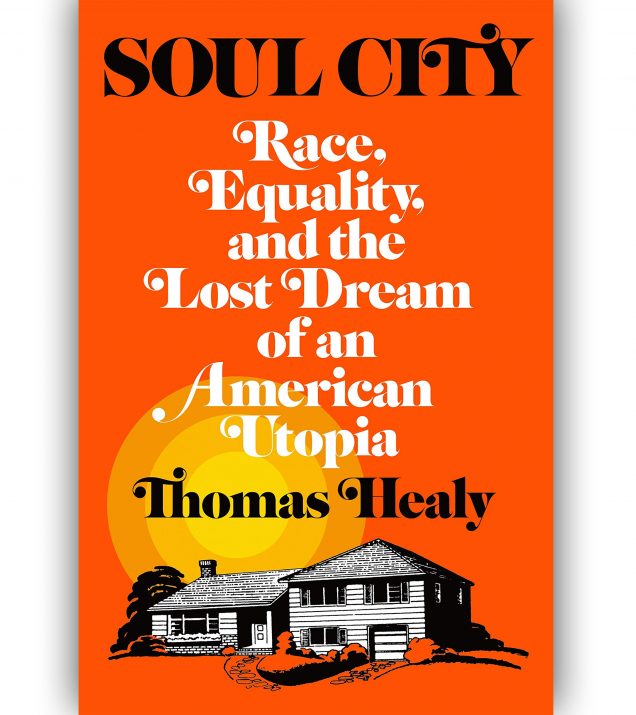If a Black man has no bread in his pocket, the solution to his problem is not integration. It’s to go get some bread.
—Floyd McKissick, the intellectual architect of Soul City, North Carolina
Seton Hall law professor Thomas Healy released ☛SOUL CITY: RACE, EQUALITY, AND THE LOST DREAM OF AN AMERICAN UTOPIA [pub: Metropolitan Books/Henry Holt and Company] at the beginning of Black History Month and quite frankly, it’s not only a must-read for any and every month of the year, but a must-own for bookshelves and a must-teach for classrooms. In 1969, a lawyer named Floyd McKissick launched his idea of Soul City—a new city where Black people would have a majority share of power, capital, and opportunity. The plan would, in theory, slow the northern migration of so many Black folks and “bring money and jobs to a region that had been left behind by the twin forces or industrialization and urbanization… When the economies of rural areas collapsed, their residents poured into the cities in search of opportunity, which only exacerbated the overcrowding and destitution of the slums. Therefore, McKissick believed, it was vital to address rural poverty, too.”
The prologue opens in 1972 with McKissick, once the head of CORE [the Congress Of Racial Equality], leading a New York Times reporter across “green fields and red clay roads” of an old Warren County, North Carolina plantation—a place where 40 percent of its residents lacked indoor toilets, seven out of ten adults never graduated from high school, and where “one roadside billboard boldly proclaimed ‘Klan Country.’” Weeks before the Times visit, “the Nixon administration had awarded Soul City a $14 million loan guarantee, (the equivalent of about $87 million today) to prepare the land for development… If entire towns could be reconstructed in post-war Europe, [McKissick] thought to himself, why couldn’t Black people build new cities in the United States?”
I’ve been preaching this books’ gospel since I swiped it open on my tablet. For my academics, intellectuals and history enthusiast, Healy’s notes, bibliography and acknowledgements alone are worth a dedicated read. I can’t help but admire his level of devoted and “meticulous” research. That said, Healy crafted an incredible documentation of a quest for Black economic empowerment, “advancement and a haven from racial oppression” with references to not only Tulsa/Black Wall Street and Liberia, but lesser-known Black towns and settlements like Brooklyn, Illinois, Port Royal, South Carolina, and the Maroons of North Carolina. Kudos to Healy. This encyclopedia of hidden Black facts, history and data read more like a Black power blockbuster than a sleepy work of non-fiction.
What Black residents in Ferguson, Baltimore, Charlotte, Minneapolis, and so many other cities are demanding today is the same thing McKissick was seeking nearly five decades earlier: respect, dignity, and control over their own destiny.
—Thomas Healey, author of Soul City
Following Healy as he turns down Brown Blvd. and Turner Road, named after revolutionary abolitionists John Brown and Nat Turner, my heart swelled with pride for what could have been. But when Healy discovers Soul Tech One, “a manufacturing plant built in 1975 in hopes of attracting industry” had been converted into a soap factory staffed by inmates earning 15 cents an hour, down the street from a medium-security prison I snarled my lips in disgust.
Healy’s goal with Soul City? … “to understand the forces that led to its downfall and the lessons it offers for the pursuit of racial equality today.” Achieved.
Full disclosure: I was unable to finish the NetGalley ebook loaned to me before it was archived. So I borrowed the audiobook from New York Public Library and am I ever grateful that I did. The narrator, Larry Herron, is excellent. He sounds like a bit like President Barack Obama, but with more rhythm and a better two-step. Respectfully, have you seen our Forever President dance?
Soul City: Race, Equality, And The Lost Dream Of An American Utopia Synopsis from Macmillan:
The fascinating, forgotten story of the 1970s attempt to build a city dedicated to racial equality in the heart of “Klan Country”…
In 1969, with America’s cities in turmoil and racial tensions high, civil rights leader Floyd McKissick announced an audacious plan: he would build a new city in rural North Carolina, open to all but intended primarily to benefit Black people. Named Soul City, the community secured funding from the Nixon administration, planning help from Harvard and the University of North Carolina, and endorsements from the New York Times and the Today show. Before long, the brand-new settlement – built on a former slave plantation – had roads, houses, a health care center, and an industrial plant. By the year 2000, projections said, Soul City would have fifty thousand residents.
But the utopian vision was not to be. The race-baiting Jesse Helms, newly elected as senator from North Carolina, swore to stop government spending on the project. Meanwhile, the liberal Raleigh News & Observer mistakenly claimed fraud and corruption in the construction effort. Battered from the left and the right, Soul City was shut down after just a decade. Today, it is a ghost town – and its industrial plant, erected to promote Black economic freedom, has been converted into a prison.
In a gripping, poignant narrative, acclaimed author Thomas Healy resurrects this forgotten saga of race, capitalism, and the struggle for equality. Was it an impossible dream from the beginning? Or a brilliant idea thwarted by prejudice and ignorance? And how might America be different today if Soul City had been allowed to succeed?







What do you think?
You must be logged in to post a comment.